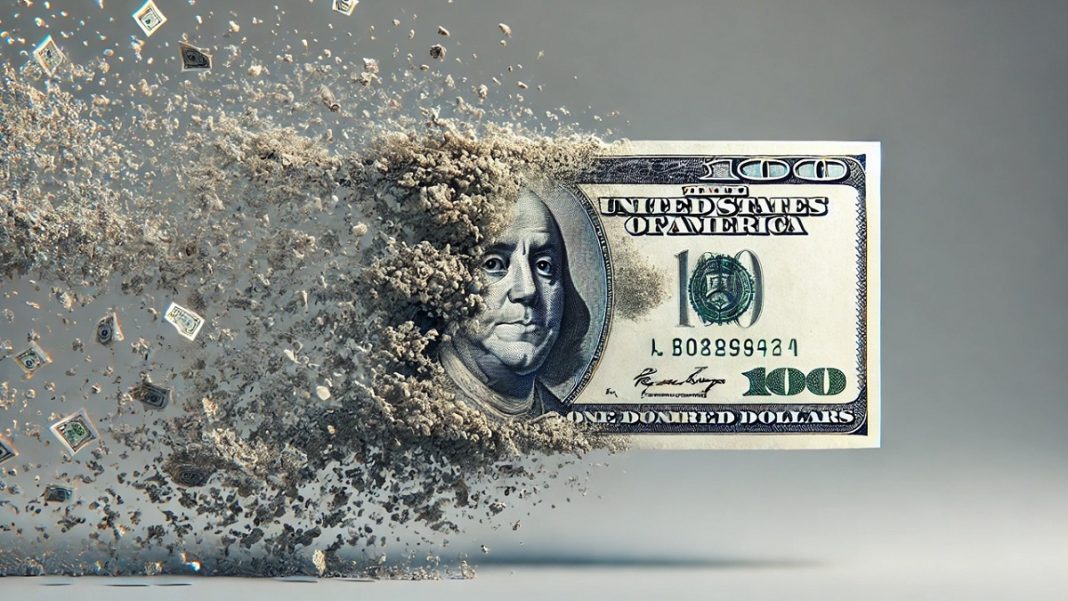Gabriel G. Tabarani
For nearly eight decades, the U.S. dollar has been the world’s unrivaled anchor currency. It has been the lubricant of global trade, the storehouse of central bank reserves, and the safe harbor for investors in times of turmoil. This “exorbitant privilege,” as the French once called it, has allowed the United States to finance its deficits at low cost and sustain global influence far beyond what raw economic size alone would dictate. But new research suggests that this privilege is far more fragile than Washington assumes. And it may be undone not by foreign rivals, but by America’s own turn inward.
A new Brookings study shows how a trade war—fueled by tariffs and retaliatory measures—undermines the very foundations of dollar dominance. The dollar’s supremacy rests on two pillars: its role as a safe-haven asset and its function as the anchor currency for countries seeking stability in their own exchange rates. Both pillars depend critically on America’s openness to global trade. Cut those trade links, and the logic of dollar centrality unravels.
The mechanics are subtle but profound. In times of global crisis, the dollar tends to appreciate because shocks that hit the United States reverberate across the world economy. This makes dollar assets safe and lowers U.S. borrowing costs. Small countries, in turn, peg their currencies to the dollar to “import” its safety. The result is a self-reinforcing dollar-centric system: more stabilizations mean more demand for dollars, which strengthens its role as the world’s reserve currency.
But tariffs disrupt this equilibrium. When the U.S. erects barriers, it insulates itself from the world economy. Fewer U.S. shocks spill over globally, weakening the dollar’s appeal as a hedge. In Brookings’ calibrated model, once tariffs climb past about 26%—a level not far from the Trump administration’s threats in 2018—the euro overtakes the dollar as the safer store of value. Small countries, seeking insurance, begin pegging to the euro instead. In this world, the dollar’s anchor status collapses almost overnight, replaced by a looser euro-based system.
The consequences for the U.S. are stark. First, interest rates rise. Today, American borrowers enjoy an interest-rate discount of roughly 2.5 percentage points compared to small, trade-exposed countries. That gap reflects the dollar’s safe-haven status. If tariffs erode the dollar’s safety, this privilege shrinks or even inverts. Borrowing costs for the U.S. government and firms climb, undermining growth and investment.
Second, capital flows reverse. As U.S. firms lose value in global markets, investors redirect funds abroad. The Brookings model predicts sustained outflows in the face of entrenched tariffs, a dynamic that could even pressure Washington to impose capital controls. For a nation that has championed open financial markets, that would mark a dramatic reversal.
Third, welfare shifts geographically. When countries peg to the dollar, they provide the U.S. with “consumption insurance”: cushioning Americans against shocks by absorbing some of their risk. Shift those stabilizations to the euro, and the insurance premium flows to Europe instead. For the euro area, this would be an economic windfall. For the U.S., it would be a material loss of global economic leverage.
Critically, these dynamics don’t require the dollar to disappear from trade overnight. Even a partial erosion of trust has cascading effects. Central banks may rebalance reserves toward euros. Multinational firms may invoice more contracts in alternative currencies. Lenders may charge Americans higher premiums to borrow. Step by step, the dollar’s gravitational pull weakens. And once confidence ebbs, it is devilishly hard to restore.
Some argue that no other currency is ready to assume the dollar’s mantle. China’s renminbi remains hamstrung by capital controls, and the eurozone faces its own structural vulnerabilities. But this is cold comfort. The Brookings research makes clear that in the event of a severe trade war, countries won’t need a perfect substitute. They will settle for “good enough.” And the euro, with its deep financial markets and relative political stability, fits the bill better than many in Washington care to admit.
The irony is painful. America’s global financial dominance was not imposed on the world; it emerged organically from free trade and open capital markets. Now, nationalist trade policies threaten to erode the very system that underwrites U.S. economic power. This is not merely about tariffs on steel or soybeans. It is about the strategic architecture of global finance.
The policy lesson should be clear: preserving dollar dominance requires preserving global openness. Protectionism carries hidden macroeconomic costs far beyond consumer prices and supply chains. It undermines the very foundation of America’s financial might. The temptation to “weaponize” trade may play well in domestic politics, but it risks disarming America’s most powerful global asset: the dollar.
In the end, the dollar’s fate is not in the hands of Beijing or Brussels. It is in Washington’s own. A retreat from globalization would be a retreat from dollar supremacy. And without the dollar’s anchor status, America would find itself paying more to borrow, competing harder for capital, and wielding less influence abroad. That is the real price of tariffs—and it is one the United States can ill afford.
This article was originally published in Arabic on the Asswak Al-Arab website


